Help desk software was my daily command center when I worked at HubSpot Support. Our customer service ticketing system was the brain of daily operations for the support team and me as a whole. It was central to my workflow and experience as a support rep, and I can’t understate its impact on my ability to solve for the customer.
Without a proper ticketing system or help desk solution, scaling and maintaining a customer service team is nearly impossible. In my opinion, choosing the right help desk solution is just as critical as hiring the right people.
Get Started with HubSpot's Help Desk Software for Free
Are you looking for the right help desk software for your team? I’ve got you covered. In this article, I’ve compiled 12 of my favorite help desk solutions to help you make the right choice. But before we get there, let’s talk about what a help desk is, how to choose one, and why you should use one.
Table of Contents
- Help Desk Software Features
- The Top Free Help Desk Software
- What is a help desk?
- Benefits of Free IT Ticketing Systems
- How to Choose the Right Support Ticketing Tool
- How I Chose the Best Help Desk Software
- Find the Right Help Desk Software for Your Team
.webp?)
Free Help Desk & Ticketing Software
Keep track of customer requests in one unified help desk that connects to your CRM database.
- Provide personalized, AI-powered support to your customers
- Save time, reduce errors, and streamline service processes
- Improve rep efficiency & time to resolution
- And more!
What is a help desk?
A help desk distributes incoming service requests to support team members and helps them manage follow-up communication on long-term cases.
Help desks come with several valuable features, such as:
Help Desk Software Features
- Knowledge Base
- Ticket Management
- Ticket Automation
- Ticket Escalation
- Ticket Distribution
- Multiple Contact Options
- Customer Support Analytics
Knowledge Base
A knowledge base is a self-serve library of information that helps customers find answers to troubleshoot problems without contacting a customer service rep. 79% of businesses offer a knowledge base to help customers independently solve their issues.
We have a perfect one here at HubSpot, and several of my colleagues contributed to it. We also had an “internal knowledge base” private to HubSpot support reps, which was invaluable in answering employee questions.
Whether internal or external, most knowledge bases include the following:
- Directions and tips for using your products and services.
- Answers to FAQs.
- Content you've created that can provide in-depth solutions.
- Video demonstrations.
- Company information.
- Info on different business departments.
Ticket Management
Ticket management streamlines customer support requests. This feature lets you receive and assign tickets, track their progress, and escalate issues when necessary. You can also organize tickets based on priority, status, and severity, shortening your response time for time-sensitive matters.
At HubSpot, our ticket management system prioritized tickets that had been in the queue the longest. These tickets were assigned to reps first unless there was a critical situation where we needed to act on other cases immediately.
Ticket Automation
A customer support rep handles an average of 21 tickets per day. Ticket automation allows you to set up triggers and rules that automatically assign tickets, send notifications, and perform other actions based on specific conditions.
This allows you to streamline your workflow and focus on higher-value tasks, and it can also provide customers with a better frontline experience.
Ticket Escalation
Ticket escalation is the process of moving a customer support ticket from an initial representative who isn't able to resolve the issue to a higher-level rep or manager. Help desk software can help with this process by ensuring high-priority problems get the attention they deserve.
For instance, you can set up automations that prioritize high-severity tickets and route technical issues to more senior representatives. At HubSpot, we would route questions related to payment services to our billing department since they were more equipped to handle these issues.
Ticket Distribution
56% of customers say they have to repeat themselves when they’re handed off to a more experienced rep. Ticket distribution helps get a ticket to the most appropriate service rep the first time. In my opinion, ticket distribution is the foundation of any help desk.
This feature automatically routes tickets to the appropriate rep based on their skill set, availability, and/or workload. Managers can also use ticketing software to monitor ticket distribution, reallocate tickets when necessary, and maintain a balanced workload across their teams.
Multiple Contact Options
Help desk software gives customers options when contacting your business. These options range from traditional phone and email support to live chat and conversational bots.
Reps don't have to specialize in one channel, either. When I worked in support, I received tickets from social media, live chat, and email, all in one inbox. The outgoing messages appeared to be coming from the same channel the customer contacted.
Having multiple communication channels available to your customers will help you effectively meet their needs and increase their overall satisfaction.
Customer Support Analytics
Customer support analytics provide valuable insights into your customer service efforts — they also let you know as a rep whether or not you're having a good day.
These features track performance metrics, such as knowledge base usage, ticket volumes, response times, customer feedback, etc. This information can be used to improve support processes and identify areas where additional service resources are needed.
If these features aren‘t enough, let’s discuss some valuable returns from adopting this software.
.webp?)
Free Help Desk & Ticketing Software
Keep track of customer requests in one unified help desk that connects to your CRM database.
- Provide personalized, AI-powered support to your customers
- Save time, reduce errors, and streamline service processes
- Improve rep efficiency & time to resolution
- And more!
Benefits of Free IT Ticketing Systems
1. They efficiently manage support requests.
75% of CRM leaders say they’re receiving more support requests than ever, which makes a support ticketing system necessary.
With ticketing systems, your team can manage support requests much more efficiently than you would if you did everything manually. It allows you to receive, track, and assign tickets to individual contributors or groups in one centralized place, ensuring that each request is addressed promptly.
Help desk software automates tedious processes like ticket routing, escalation, task creation, and customer marketing emails. In my experience, this reduces time spent handling routine tasks and gives you more time to focus on deeper, more complex problems.
2. They increase the bandwidth of your support team.
92% of CRM leaders say AI has improved their customer service response time. Since these systems simplify the organization and management of support requests, your team will have more bandwidth to serve a higher volume of customers in less time.
Additionally, because they allow you to automate many routine tasks, there's more room to work on new strategies and projects.
A good example? Yours truly. I used my free time to write about customer service. Not only did I parlay that into a career, I generated free marketing content for HubSpot while working in customer support.
3. They improve customer satisfaction.
A free IT ticketing system can help improve customer satisfaction by streamlining your company's support process and handling customer issues promptly. Because of the multiple contact options, such as chatbots and live chats, customers have more tools to communicate with support staff about their needs.
78% of customer support leaders say their customers prefer to solve issues independently. Self-service options, like knowledge bases, help customers find solutions to problems independently, reducing the need to contact support staff.
4. They save your company money.
The average customer support professional uses four separate tools to support their role. A subscription to each of these tools adds up quickly. Support ticketing systems often combine the tools into one platform.
While free IT ticketing systems may not have all the bells and whistles of a premium version, they will get the job done in a pinch and save you money while you figure out which system is best for your company.
Premium and enterprise-level help desks have additional features to improve your customer experience, although these systems can be pricey. A paid version may not be possible or advantageous for businesses working within a tight budget.
Before you even begin shopping for a customer support tool, you need a plan. Check out this free customer support strategy template to get started.
Ready to start shopping for your ticketing system? Let's take a look at some of the top help desk software and ticketing systems your team can start using for free.
The Top Free Help Desk Software
- Best overall: HubSpot Help Desk
- Best for small businesses on a budget: Help Scout
- Best for customer experience management: Groove
- Best for e-commerce desks: UVdesk
- Best for customer-facing help desks: Hiver
- Best for small business IT: Freshdesk
- Best for ITSM Compliance: Spiceworks
1. HubSpot Help Desk
Start using HubSpot's Free Help Desk and Ticketing software.
HubSpot's Free Help Desk and Ticketing Software is a unified help desk dashboard where all customer requests are stored so your entire team can easily track, prioritize, and manage them.
Staying organized becomes more challenging as you scale your business, making it more challenging to give each customer issue the attention it deserves. HubSpot allows you to monitor each issue and efficiently resolve it.
Key Features
- AI-powered efficiency: Built-in AI powers automatic recommendations, and AI assistant features encourage rep efficiency at every click.
- Personalized support: HubSpot Help Desk integrates with your marketing and sales data to provide personalized support with unified customer insights built into every interaction.
- Ticket automation and routing: Tickets are automatically assigned to the appropriate rep using skill-based assignment and intelligent routing.
- Unified analytics: Gain full visibility into customer metrics to understand recurring issues and keep a pulse on customer health.
Pros
- Seamless integration with HubSpot CRM: Directly connects with HubSpot CRM to eliminate data silos and bring clarity across your organization.
- Automation features: Not always available in free products, but we’ve got them!
- Scalability: HubSpot is equipped to handle your business needs across all departments as you grow, unifying Sales, Service, Marketing, Operations, and more.
Cons
- Limited seats: You’ll need to upgrade or purchase additional seats.
- Limited email templates: Limited to five email templates at the free level.
Best for: Businesses of all sizes looking to unify information across all internal teams, especially those already using HubSpot CRM.
What I like: I love HubSpot because it unifies all of your customer data so that you can provide a 360-degree customer experience. When I use HubSpot, I have complete visibility into a customer’s history, past tickets, and which representative they have worked with before. Armed with a full customer timeline, I can provide personalized, empathetic support and fully understand the customer’s needs and challenges.
HubSpot’s Help Desk and Ticketing software are just pieces of the puzzle. You can also use its all-in-one customer service software to streamline all your service efforts from the same place. For example, you can gauge your team’s performance by monitoring metrics like average response times and close times. You can also deploy and manage feedback surveys and more.
Pro tip: Use HubSpot's Help Desk software to track all customer requests, manage tickets, and prioritize and distribute work among reps.
Pricing: You can get started with HubSpot’s Help Desk for free. For more functionality, consider upgrading to the Service Hub Professional tier for $90 a month per seat.
.webp?)
Free Help Desk & Ticketing Software
Keep track of customer requests in one unified help desk that connects to your CRM database.
- Provide personalized, AI-powered support to your customers
- Save time, reduce errors, and streamline service processes
- Improve rep efficiency & time to resolution
- And more!
2. Zoho Desk
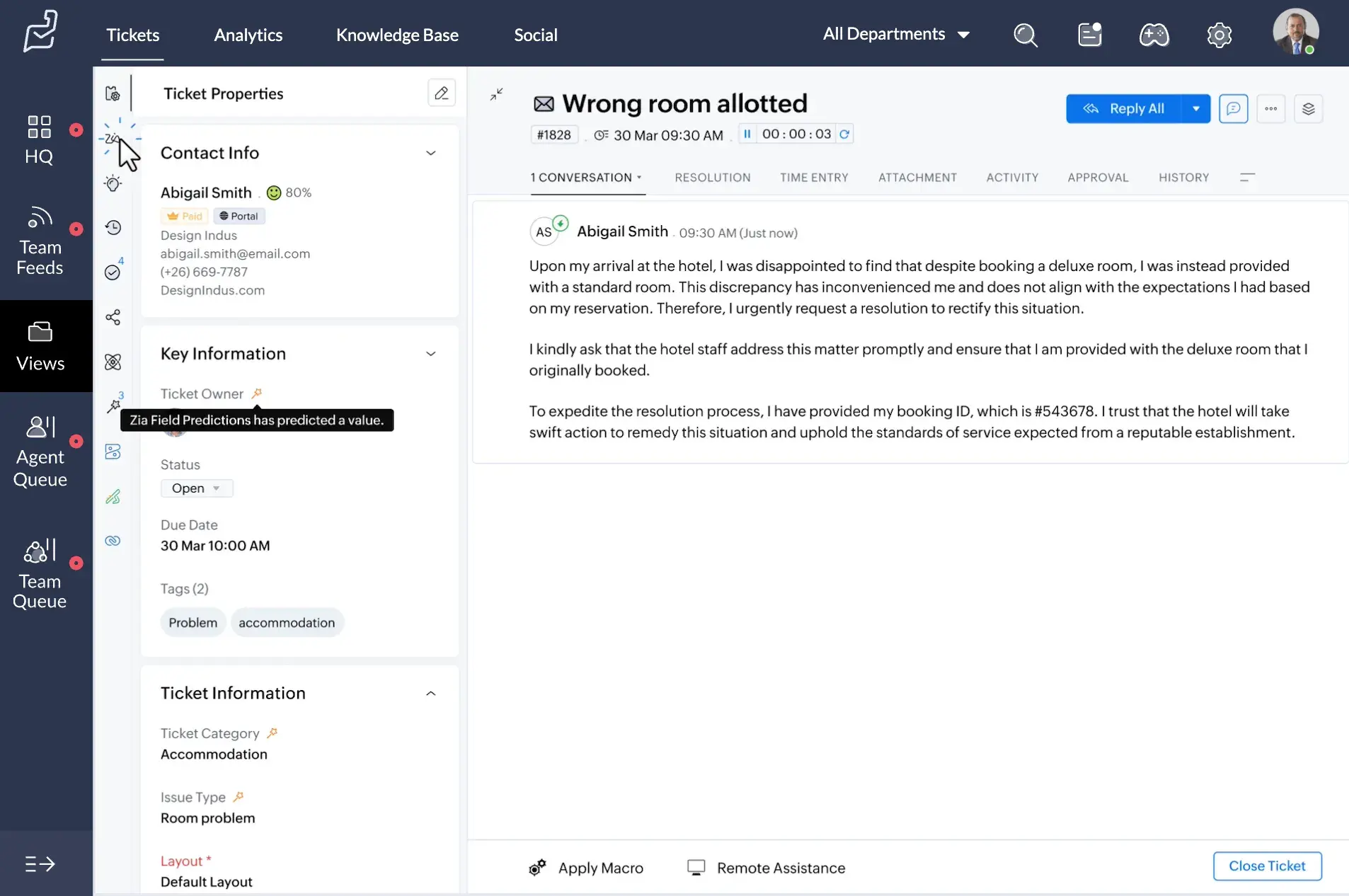
Zoho Desk is a multi-channel help desk ticketing system designed to help businesses manage customer service operations efficiently. It handles incoming service cases via phone, web, email, chat, and social media, making for an omnichannel experience.
Key Features
- Ticket management: Manage, organize, and track incoming support tickets.
- Multi-channel support: Centralized email, social media, and web forms.
- Knowledge base: Maintain a self-service hub so customers can answer questions independently.
- Mobile app: Stay on top of tickets on the go with the Zoho Desk mobile app.
- Contextual AI: Zoho’s Zia quickly answers customer queries, identifies and tags support tickets, and detects anomalies and unusual ticket activity.
- Automation: Automate ticket assignments, escalations, and workflows.
- Integration: Connect Zoho Desk with other software or embed applications and widgets.
Pros
- Search functionality: Simple, attractive, and intuitive to use.
- AI tools: Generates responses, monitors data, and detects unusual activity.
- Multi-channel support: Handle tickets from email, social media, and web forms.
Cons
- Steep learning curve
- AI tools: Requires your own ChatGPT API.
- Reporting and analytics: Reports can be a bit complex.
Best for: Small businesses, startups, or freelancers seeking a cost-effective help desk system chocked full of features to manage customer queries and tickets on a small scale.
What I like: Zoho Desk offers a widget tool that you can embed on your website. When loaded in a browser, the widget turns into a support form that customers can fill out to request assistance. They can describe their problem in detail and request a preferred communication channel.
This makes it simple for customers to access your support team. It also allows reps to analyze and find solutions for incoming requests easily, significantly improving first-call resolution rates and customer satisfaction.
I also like their time-tracking feature, which records how much time you spend doing different things on each ticket. This gives you more insight into the hurdles a rep has to overcome to solve a specific issue.
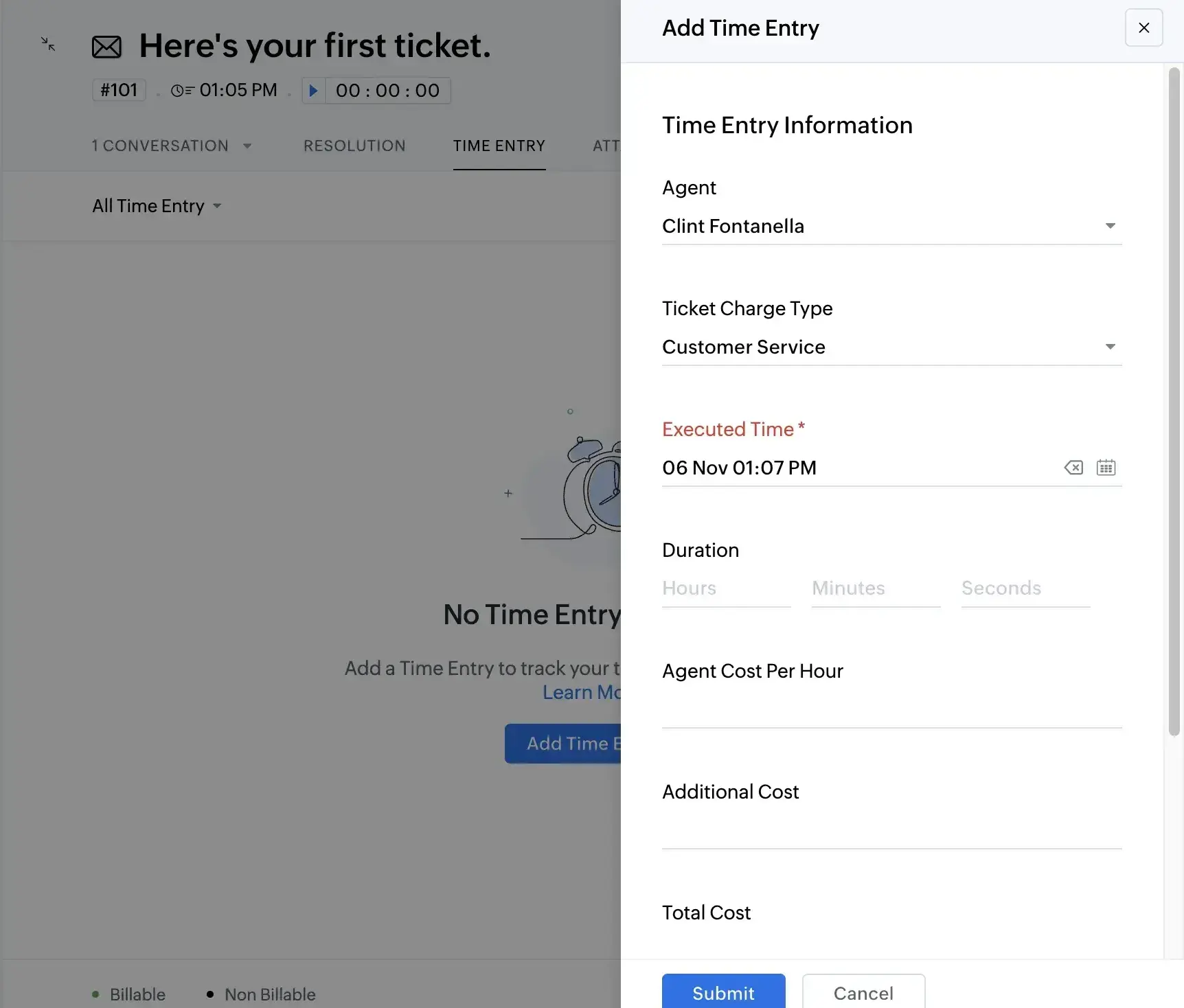
Pricing: You can sign up for a free 15-day trial of Zoho Desk. After your trial, you’ll need to upgrade to a paid plan. Paid plans start at $7 a month for the Express tier and increase to $40 a month for enterprise-level users.
3. Groove
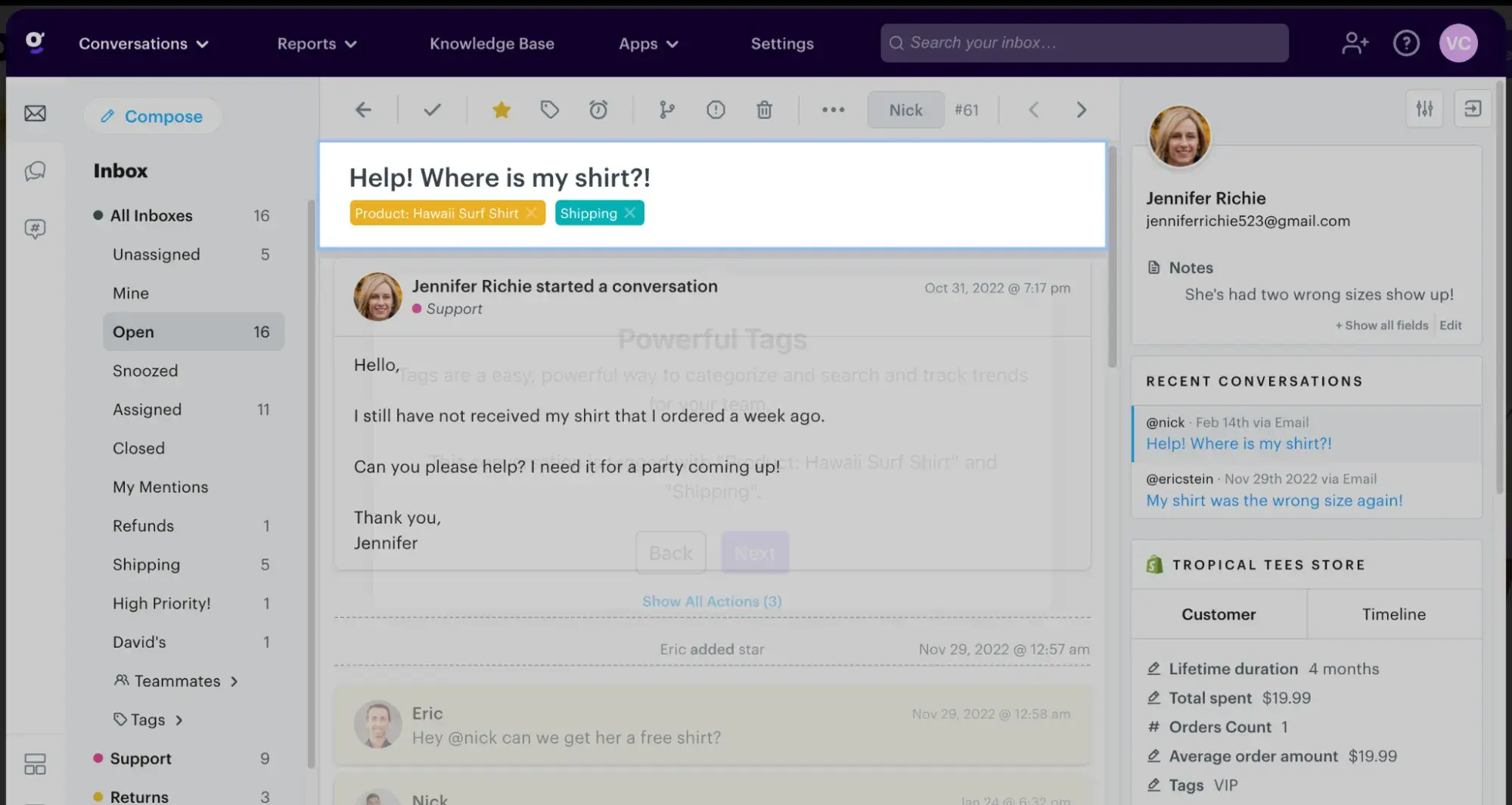
Of all the options I tested, Groove is one of the simplest and most cost-effective cloud-based help desk software solutions for small businesses. It helps companies personalize their communication with their customers via email, live chat, social media, and phone calls.
Over 10,000 users trust Groove as a simple yet powerful Zendesk and Freshdesk alternative. According to them, Groove’s help desk is easier to use, quicker to set up, and provides a much better customer experience.
Key Features
- Shared inbox: Organize your messaging channels, including email and Slack, to streamline and align ticketing support.
- Self-service knowledge base: Create a branded knowledge base paired with analytics to help track performance metrics.
- Live chat: Chat with your customers across your app or website, or enable automation to collect customer information in the off hours.
- Reporting and analytics: Understand your customer satisfaction rates, conversions, and conversations.
Pros
- User-friendly interface: Simple, attractive, and intuitive to use.
- Collaboration tools: Enable support teams to work together effectively.
- Multi-channel support: Handle tickets from email, social media, and web forms.
Cons
- Limited shared inboxes: Only two shared inboxes are allowed at the lowest tier.
- No AI features at lowest tier: Must upgrade to Plus or Pro for AI features.
- Basic reporting: Limited reporting capabilities at the lowest tier.
Best for: Small and growing businesses looking to personalize their support ticketing and customer interactions.
What I like: Groove felt like a more cost-effective and feature-rich alternative to companies like Zendesk and Freshdesk. During my 7-day free trial, I liked using the “instant replies” feature, which produced canned responses to recurring problems. Even more impressive, you could trigger follow-up actions within the help desk after sending the canned response.
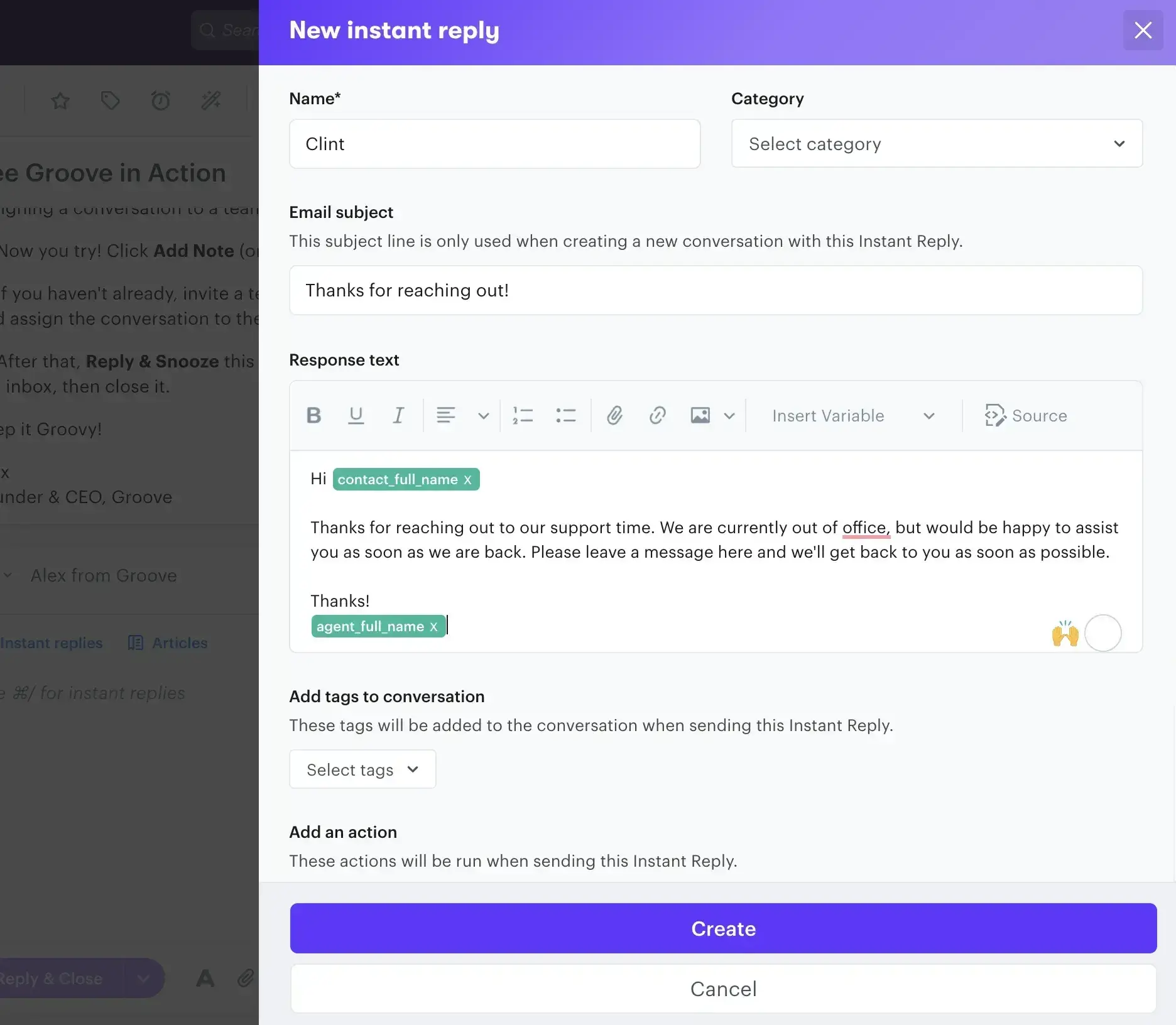
Groove’s help desk software allows companies to accept, track, and respond to support requests in an organized fashion with ticketing, live chat, knowledge base, self-service portals, SLO management, multiple mailboxes, task management, and reporting.
Pricing: You can try Groove free for 90 days. After your trial, you’ll need a subscription. Subscriptions start at $24 a month for the Standard tier, which allows for up to 25 users and two shared inboxes.
4. Spiceworks
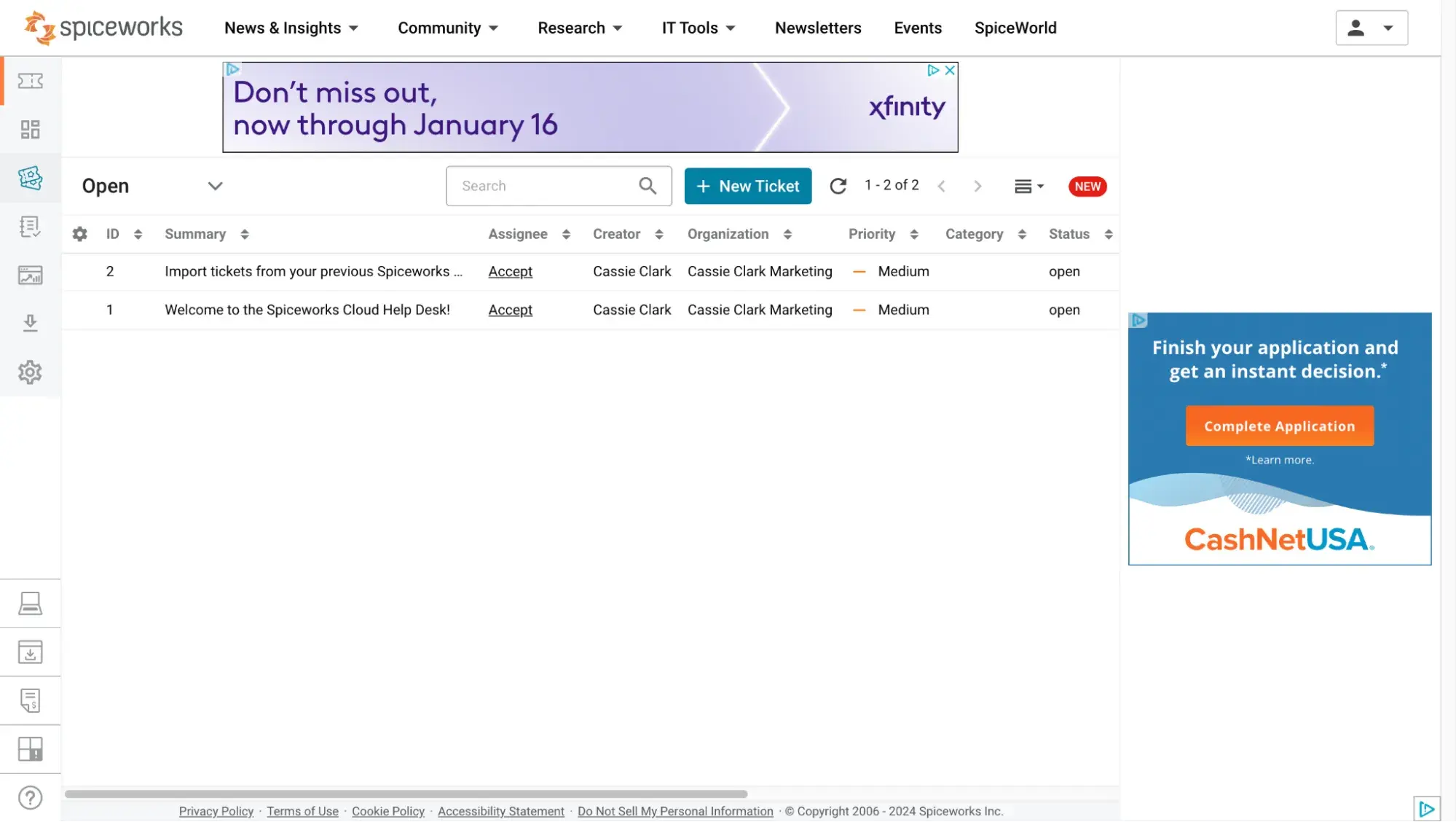
Spiceworks is a ticketing system that helps businesses manage both internal and customer-facing tasks. The software is all online in a cloud, so there's no hassle in getting it set up and maintaining it. Once I signed up, I was immediately redirected to my inbox, where I could start answering mock tickets.
Best of all, Spiceworks is free without limits on tickets, devices, or agent access. So, it's not a bad option if you just want to explore the basic features of a help desk.
Key Features
- Ticket management: Manage tickets from a shared inbox.
- IT asset management: Keep track of internal IT resources like company laptops.
- Customizable self-service portal: Unified portal for users to submit tickets and view resources.
- Advanced reporting: Create filters to quickly access open or pending tickets.
Pros
- Completely free with no upcharge.
- No user limits.
- Free mobile app.
Cons
- Basic interface: Less attractive than other paid options.
- Banner ads: It's gotta be free somehow!
- Limited support options: Community support is your only option if you need help with the software.
Best for: IT departments and small businesses who do not mind a scaled-down system if it saves them money.
What I like: Because Spiceworks is a cloud-based help desk, I could log in from any web browser and get to work. It also offers a help desk mobile app that keeps you updated on all your tickets. It is not that anyone wants to work outside of office hours, but it does give you the option to respond to customers in a pinch if needed.
Spiceworks also offers an inventory management integration that can help your team oversee product orders that are in progress. It uses an IP scanner to locate orders and notify you of their progress. As a rep, I can then proactively relay that information to the customer so they know of any delays with their delivery.
Pricing: Free.
5. Keeping

https://www.youtube.com/watch?v=2UX-R-ktFmA&t=29s
Of all the options I tested, Keeping is one of the simplest and most cost-effective Gmail-based help desk solutions for small businesses. It transforms your Gmail inbox into a shared help desk, allowing companies to manage customer support directly from their familiar email interface.
Many users trust Keeping as a simple yet powerful alternative to traditional help desk software like Zendesk and Freshdesk. According to them, Keeping's help desk is easier to use, quicker to set up, and provides a much better customer experience by eliminating the need to switch between platforms.
Key Features
- Gmail collaboration: Team members can access support tickets from a designated tab in their Gmail account. Keeping prevents duplicate work by locking tickets when an agent is working on it.
- Streamlined integration: Set up your Keeping account in less than ten minutes, including connecting your team members to the shared inbox.
- Shared notes: Maintain a ticketing record system to keep your team on the same page.
- Automation and canned responses: Keeping’s AI detects support messages, like a thank you from a customer, that do not require a response.
- Round-robin assignment: evenly distribute support tickets across your team.
- Analytics and metrics: Identify areas of performance improvements and analyze key metrics, like email volume, response time, and resolution time.
Pros
- User-friendly interface: Familiar Gmail environment reduces the learning curve.
- Easy setup: Very quick and easy to set up and try with their free trial.
- Affordable pricing: Cost-effective solution for small teams.
Cons
- Limited to Gmail users: Only works with Gmail and Google Workspace.
- No multi-channel support: Does not support channels like social media or live chat.
- Advanced features require higher tiers: Some features are only available in premium plans.
Best for: All departments who use Gmail, including HR, IT, and Finance. It also integrates with Shopify, making e-commerce support in Gmail easier.
What I like: Keeping felt like a more cost-effective and user-friendly alternative to companies like Zendesk and Freshdesk, especially for teams already using Gmail. During my free trial, I appreciated the seamless integration and the ability to manage support tickets without leaving my inbox. The automation features, like canned responses, significantly improved response times.
Pricing:
Keeping offers a 14-day free trial. Small teams who need just two workflows can subscribe to Keeping for $12 a month per user. Larger organizations with more than 10 users can subscribe to Keeping for $49 per month per user.
6. Help Scout
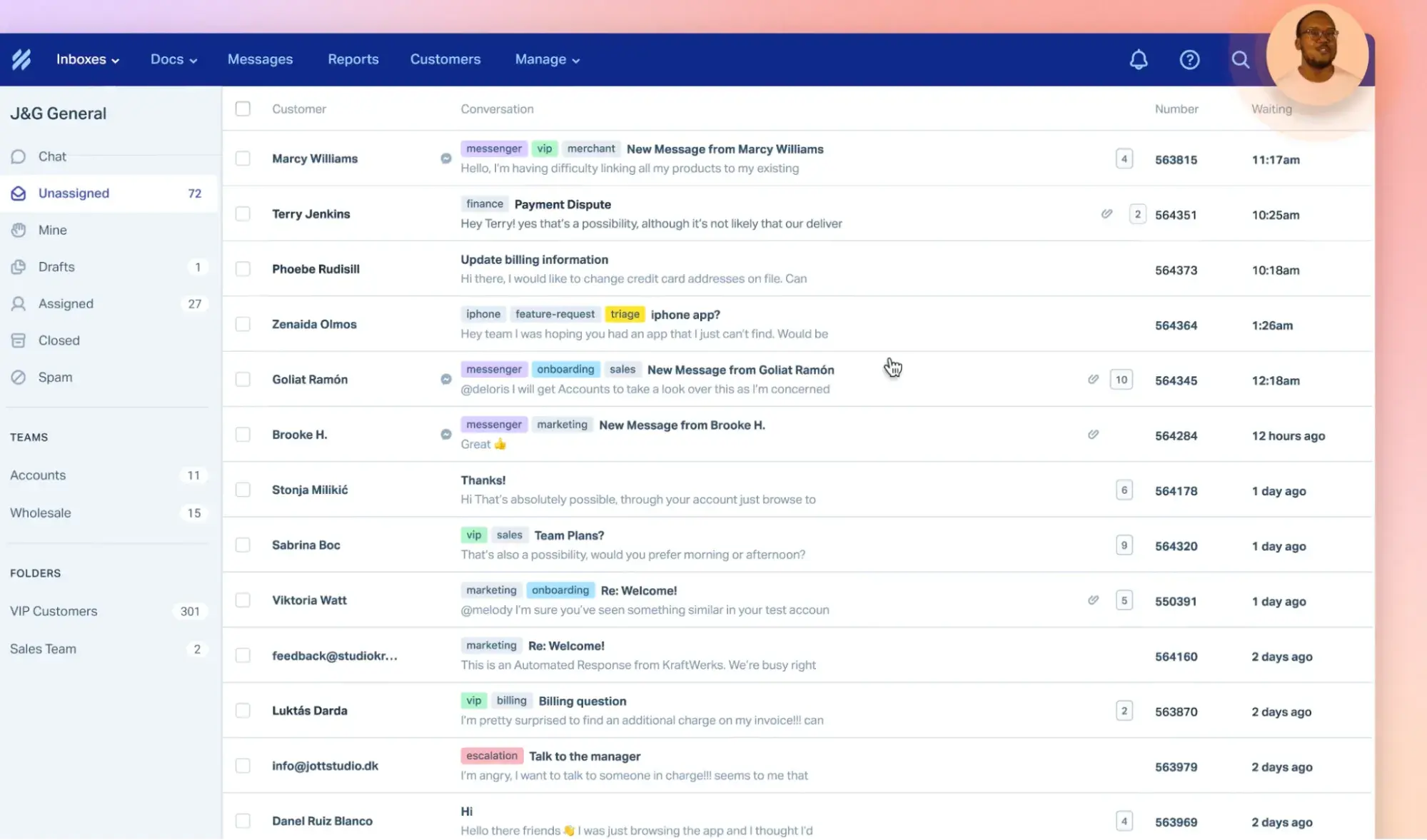
Help Scout is a ticketing system that puts the customer first. With a simple interface, the software is easy for reps and customers alike to navigate while offering excellent features such as a shared inbox, omnichannel support, live chat, automation, and a mobile app.
Although Help Scout does not offer a 100% free plan, it does offer a 15-day free trial to test the software. No credit card is required; just click it to get started.
Key Features
- Multi-channel inbox: Combine your email, social, live chat, and voice mailboxes into one streamlined interface.
- AI tools: For improving replies and summarizing conversations.
- Analytics and reporting: Access and analyze data like customer satisfaction rates, wait and response times, chat duration, and social media support metrics.
- Integration options: Such as Jira, Salesforce, Slack, Trello, and HubSpot.
- Self-service portal: Customizable to the look and feel of your brand.
Pros
- User-friendly: This is one of the more attractive and intuitive interfaces I’ve encountered.
- Collaboration tools: It's simple to loop in other agents directly on a ticket.
- Multi-channel support: Including email and live chat in a unified interface.
Cons
- Limited AI features: If you’re starting with the lowest tier.
- Storage limitations: Limited storage for attachments and data at the lowest tier.
- Basic reporting capabilities: Must upgrade to higher tiers for advanced reporting.
Best for: Startups, small businesses, or any company looking for a user-friendly interface.
What I like: Creating a chatbot on Help Scout was straightforward. In fact, it was one of the first things I did in the setup guide. I like chatbots because they are a reliable communication channel that customers can access around the clock.
Help Scout also has cloud-based features that small companies love, such as a shared inbox and knowledge center capabilities. In addition, every pricing level comes with the ability to embed help widgets on your website that you can set to fire on specific pages. In the world of many alternatives, Help Scout stands out for its simplicity and ease of use.
Pricing: If you have a small client base of 50 customers or less, you can use Help Scout for free. Or, if you have 100 or more contacts, you can try a free trial of Help Scout’s Standard subscription. Once your trial ends, you’ll pay $50 a month for your subscription.
7. Hesk
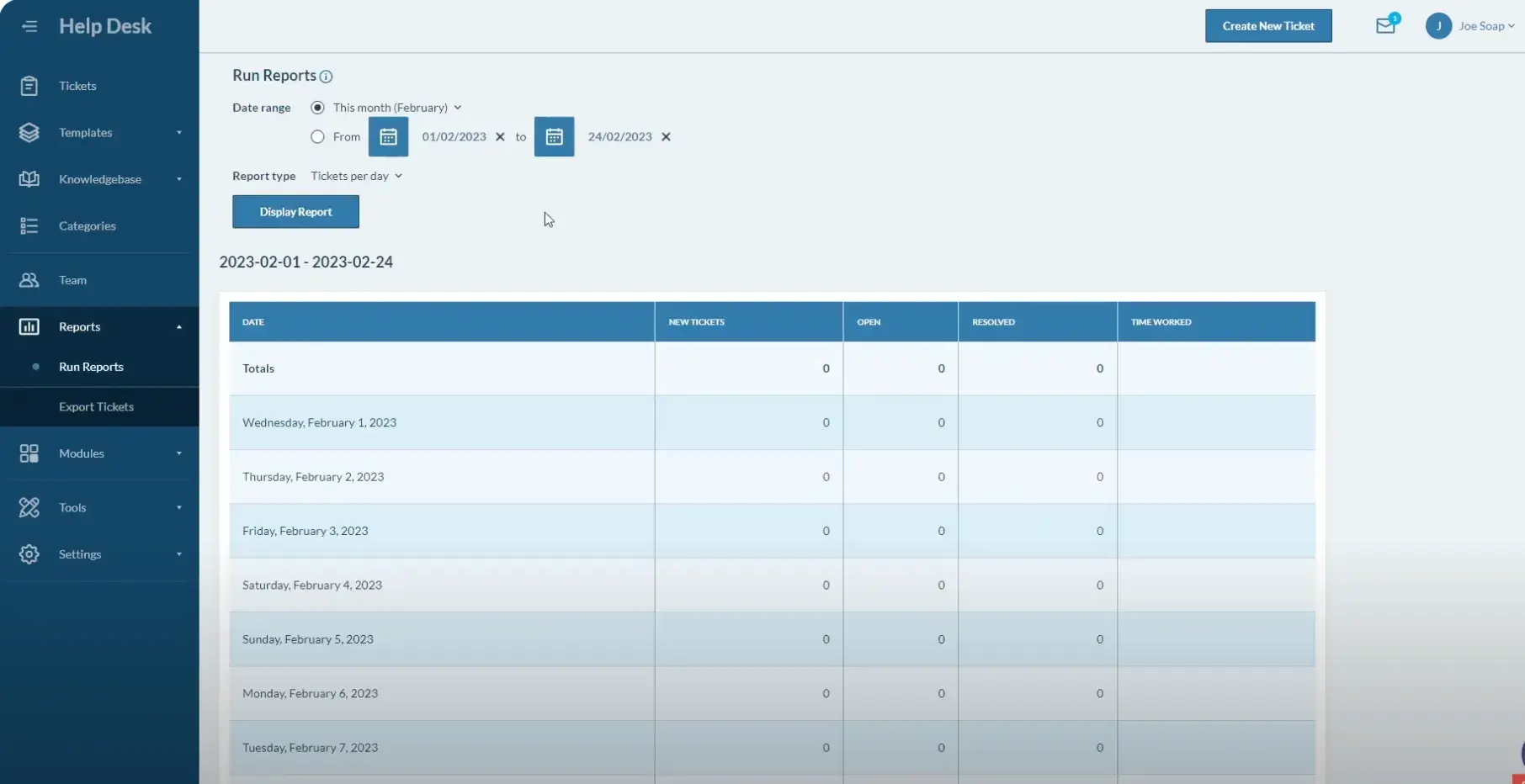
https://youtu.be/36Nx-MNLiIw?si=HZJTa1UUaM-ntSYF
Hesk is a minimal but effective helpdesk ticketing system that is completely free. I played around with the demo version for a while, and I was impressed with it, considering its non-existent price tag. The interface reminded me a little bit of the backend of a WordPress website, which was welcoming and familiar, albeit not incredibly sleek. The system was intuitive, and there were plenty of mock contacts for which you could create tickets.
Key Features
- Ticket management: Track and manage all your support tickets in one place.
- Knowledge base: Create self-service resources for customers to answer common questions independently.
- Email piping: Converts incoming email to Hesk tickets.
- Reporting tools: Essential customer service reports and analytics.
- Customer-facing interface: A single location for customers to find knowledge articles, submit a ticket, or review their ticket status.
Pros
- Unlimited users: Most competition limits the number of users per tier.
- Simple install and configuration: Get up and running quickly.
- Essential feature set: Basic yet functional capabilities for organizations with limited needs.
- Robust knowledge base: Hesk offers a large knowledge base to help its users navigate and troubleshoot common issues.
Cons
- No personalization: Canned responses don’t auto-populate with the customer's name or other information.
- Limited integration options
- No AI features
- Learning curve
Best for: Small customer service teams and businesses looking for a support ticketing system without extra bells and whistles.
What I like: Hesk offers a reliable ticketing system that takes minutes to download and set up. You can create custom ticket fields and modify the display to align with your team's workflow. It even offers a ticket submission form where customers can open web-based tickets that are managed within the app. I like Hesk for basic customer support situations that only necessitate tracking email correspondence.
8. Freshdesk by Freshworks
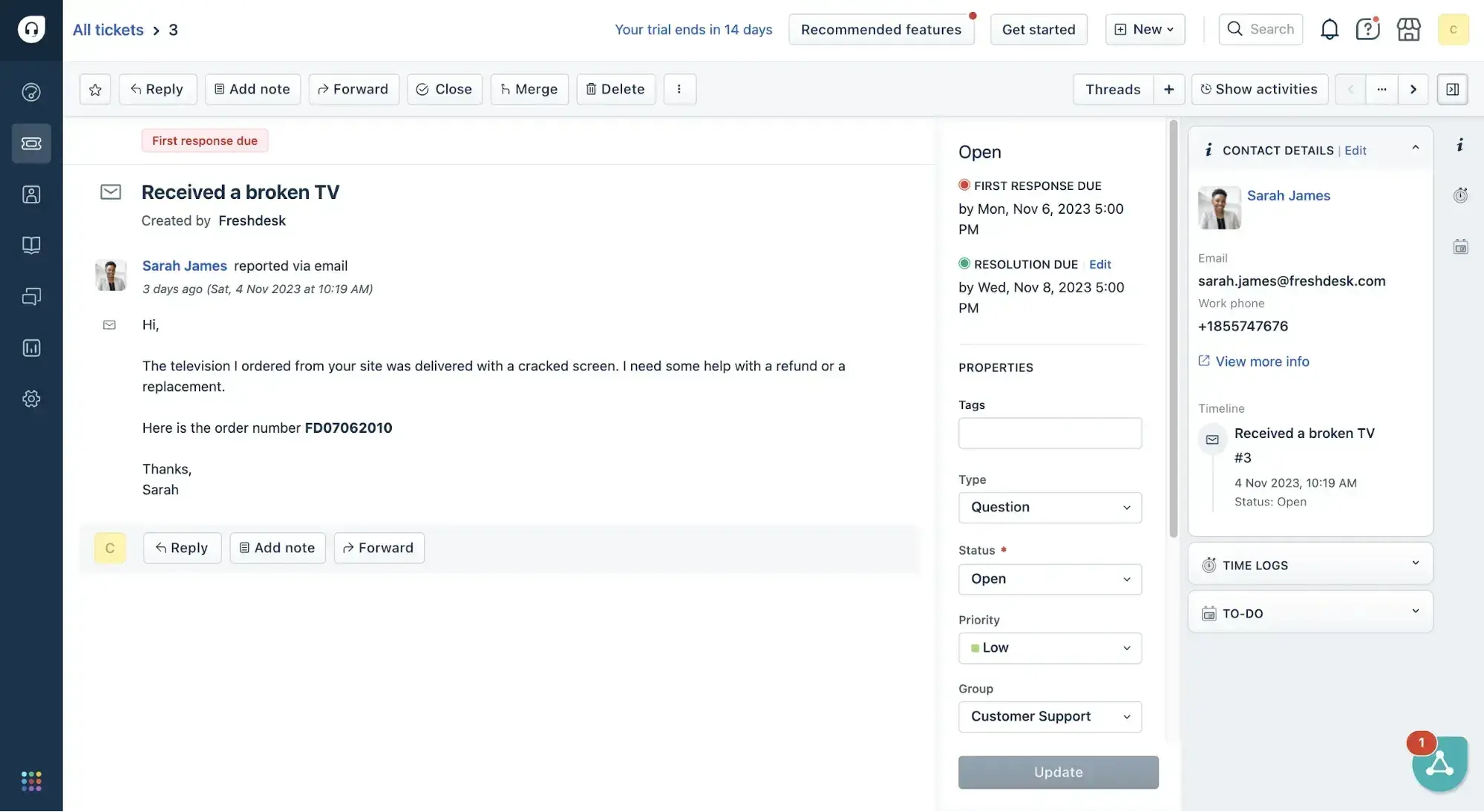
Freshdesk includes all the basic features you need to meet customers' needs, including shared inbox, social media support, automated ticket assignment, public knowledge base, and more. It allows you to collaborate with your team on high-severity issues in real time and has reporting tools that provide valuable insights that can help your team improve performance.
Freshdesk's forever-free plan provides a simple customer service solution for small businesses, startups, and teams of 10 reps or fewer. Freshworks also offers premium customer service management software through Freshservice, with plans starting at $15 per user a month.
Key Features
- Knowledge base: Create self-service resources for customers or employees.
- Ticket management: Manage and track incoming support tickets from multiple channels.
- Collaboration features: Easily loop in teammates for assistance on tickets.
- Automation: Automate admin tasks, like assigning agents support tickets.
- SLA management: Monitor, track, and assess agent performance.
- Reporting and analytics: Generate custom reports, like ticket response time and timesheets.
- Helpdesk AI: Recognizes customer sentiment and summarizes support situations to help agents quickly solve issues.
Pros
- Up to 10 users: This is a high number of seats for a free plan.
- Extensive integration options: Compatible with HubSpot, Slack, Salesforce, and more.
- Clean, attractive interface
- Quick customer support
Cons
- Limited feature set: Compared to paid options.
- Limited reporting capabilities: Advanced reporting is available at higher paid tiers.
- Limited automation: Automation features are limited to paid tiers only.
- Limited AI: AI features are limited to the pro and enterprise tiers.
- Limited customer portal: The Customer Portal feature is limited to paid tiers.
Best for: Growing companies who want to scale their support ticketing system as their client base grows.
What I like: The first thing I noticed with this help desk was how clean the user interface was. It was easy to find tickets assigned to me and different contacts and companies associated with my account. One feature I enjoyed during my demo was the To-do widget integrated into the main dashboard.
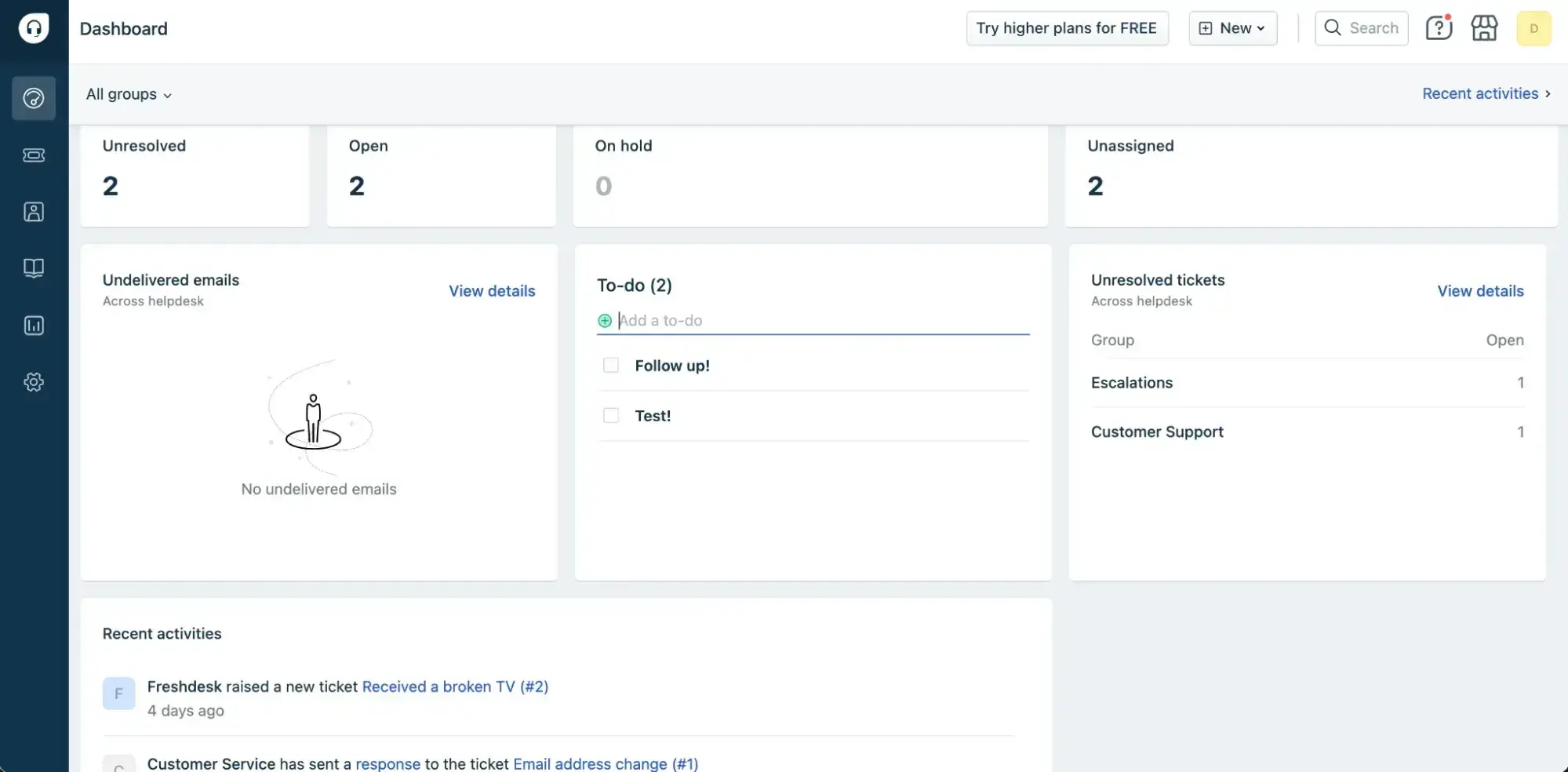
I definitely would have used a feature like this during my time as a support rep. It’s nothing crazy, but it's a little detail that makes life as a support rep a little more streamlined compared to keeping a to-do list manually or with a separate app.
Pricing: Small teams of two agents can use Freshdesk for free with limited capabilities. For teams of three or more, you’ll need a subscription. The Growth tier starts at $15 a month per agent. The Pro tier, which includes AI capabilities, is $49 a month per agent.
9. UVdesk

UVdesk is an open-source help desk software designed with ecommerce businesses in mind. Although it is aimed at online stores, I found that UVdesk is fully featured and versatile enough to benefit customer support operations across many types of companies.
I signed up for a free UVdesk account, and I’ve got to warn you that the signup process was a little wonky. The name and business name fields didn’t accept dashes (my last name and the name of my business both contain a dash symbol). When I generated a long, secure password with lots of special characters, it was marked as invalid, forcing me to use that one simple password I’ve used for a few too many websites (we all have one; don’t deny it!).
All that being said, there is a lot to love about UVdesk.
Key Features
- Ticket management: Manage and organize support tickets with customizable workflows, including ticket assignment.
- Multi-channel support: Manage email, social media, live chat, and web form inquiries as tickets in a unified interface.
- Knowledge base: Create and maintain a self-service knowledge base so customers (or your employees) can find answers to common queries.
- SLAs and escalations: Define SLAs and create escalation rules to ensure timely responses. This feature is typically not available in free help desks.
- Form builder: Create and embed customizable contact forms.
- Customer follow-up: Prompt customers to follow up with their ticketing requests by sending automatic follow-up emails.
- Helpdesk migration: Transfer your files and support tickets from your existing helpdesk to UVdesk.
Pros
- Open source: Highly customizable to fit specific business needs.
- No user limits: As many reps as your heart desires!
- Comprehensive feature set: Offers features typically only found in paid help desk ticketing systems.
Cons
- Technical setup required: The initial setup can be complex because of the product's open-source nature, likely requiring development experience.
- Basic interface: Functional but basic compared to other solutions.
- Limited support: Community support (forums) is your only resource if you need assistance with the product.
Best for: Service teams who want full control over customization of their knowledge base and support contact forms. Also great for teams who want to scale their customer support across multiple channels.
What I like: UVdesk’s superpower is its open-source nature. Why is that important? Since UVdesk is open source, the entire software code is accessible for modification, integration with other systems, custom features, and even altering the product’s UI.
Now, I don’t know the first thing about modifying open-source software. However, if someone in your business can handle such a task, UVdesk is a highly customizable and cost-effective help desk solution. In addition, I like the increased security factor since all users can inspect and maintain the source code to eliminate vulnerabilities, hidden backdoors, or malicious code.
Overall, UVdesk is an astonishingly fully featured and functional free product. However, these things come at a price, and this time, it isn’t money. Instead, it comes in the form of a steep learning curve and technical know-how, but once you get everything up and running, it will seriously be worth the time and effort.
Pricing: You can use UVdesk for free. If you want access to pro features, like multi-channel integration or service agent performance data, you’ll need the Pro plan. The Pro plan costs $22 a month for a minimum of two agents.
10. Front
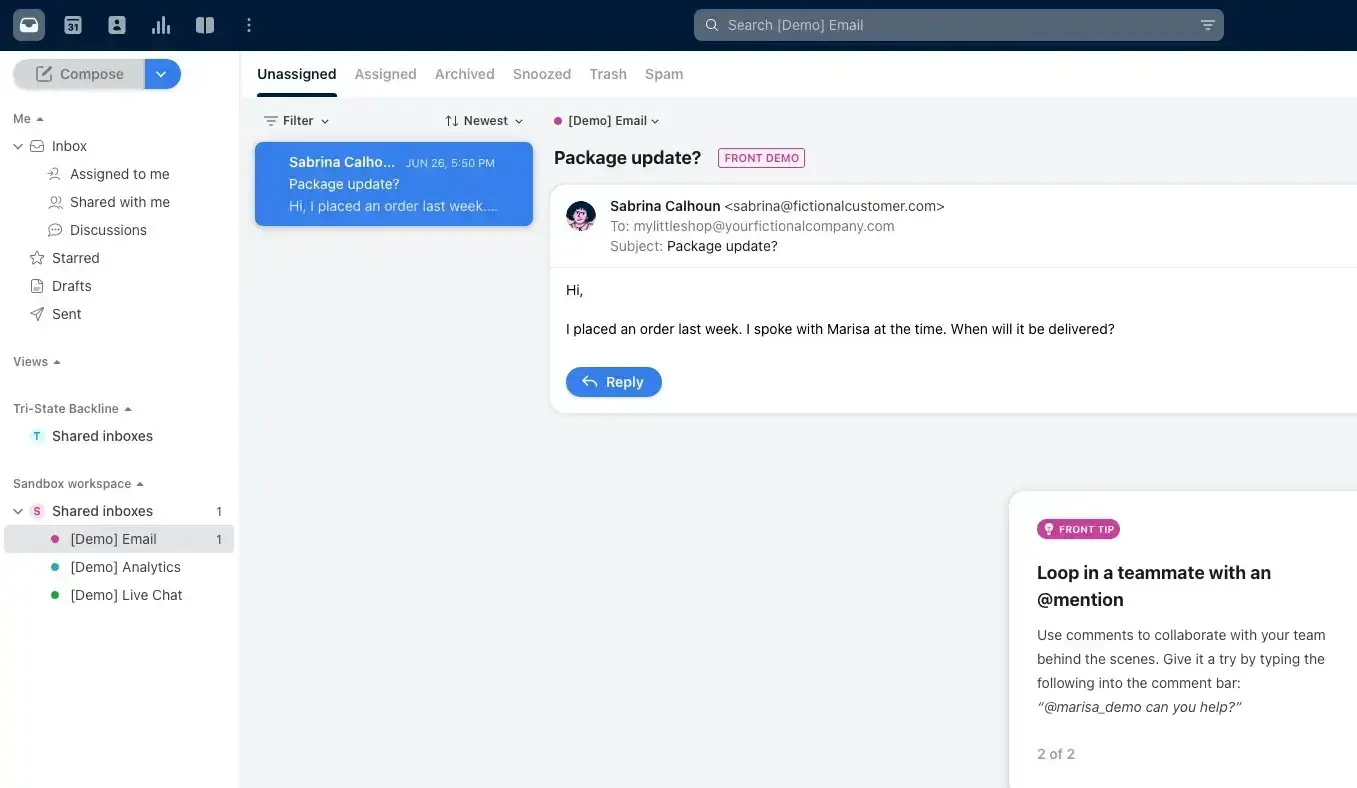
I’ll admit it. I have a weakness for modern cloud-based software with single-noun names. Front is one of those. Front is a help desk software for omnichannel customer support with streamlined communication and a focus on collaboration.
I started a free trial of Front and was impressed by the speed of the application and the intuitive UI. Front came loaded with the competitive features I expected to see, such as a shared inbox, SLAs, chatbots, and more.
One feature I enjoyed during my trial was the knowledge base. Creating and publishing articles to a sleek, blog-style interface was easy and intuitive.
Key Features
- Shared inbox: Organizes communications from multiple channels into a unified inbox for your team.
- Email management: Features like email templates, reminders, and snooze let you manage customer email communication swiftly.
- Team collaboration: Slack-style collaboration features are intuitive and encourage teamwork.
- Integrations: Integrates with many popular apps like Slack, Salesforce, and HubSpot CRM.
- Omni-channel interface: Organize your apps and channels all within the Front interface.
- Reporting and analytics: Track performance, assess workloads, and measure customer satisfaction rates.
- Front’s AI: Detects simple inquiries and provides real-time AI editing assistance in customer messages.
Pros
- Attractive interface: My favorite UI of all the products on this list.
- Workflow automation features: Not always available for free tier products.
- Intuitive knowledge base: Publishing self-service content is simple and intuitive.
- Collaboration: Allows for sidebar chats and saves them in chronological order.
- Customizable settings
- Mobile app
Cons
- Limited AI functionality: Only available with paid tiers.
- Limited storage: Storage limitations for emails and attachments at lower tiers.
- Basic reporting: Advanced reporting is only available at paid tiers.
Best for: Collaborative teams who offer customer support across various platforms, including social media and email.
What I like: If your team uses Slack for communication and collaboration, you’ll feel at home with Front. Front features an internal messaging system that lets you collaborate with other reps, comment on tickets, and tag users with the familiar @username format to loop them in where attention is needed.
I like Front because it feels modern, sleek, and intuitive. Front’s interface sparks a little bit of joy in me, which is important if you’re going to be staring at it day in and day out.
Pricing: You can try Front for free. However, once your trial ends, you’ll need to upgrade to a paid tier. The Starter Plan is $19 a month per agent.
11. Hiver
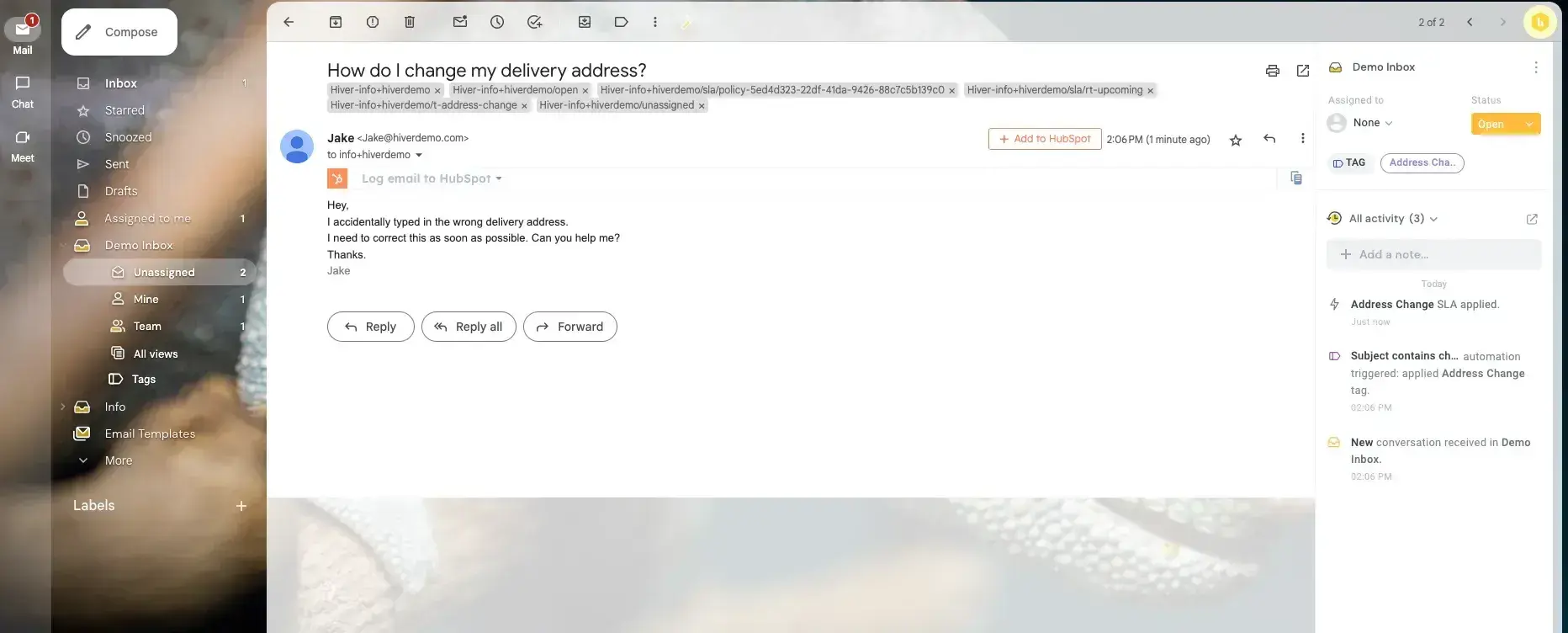
Hiver is a clever app that transforms your Gmail inbox into a fully-featured customer service ticketing system. Using Hiver, you can manage incoming customer inquiries, collaborate with teammates, set up approval workflows, and more from your Gmail inbox.
I started a free trial of Hiver and installed their Chrome extension. The added UI elements to my Gmail inbox were unobtrusive, and I could create a shared inbox in a matter of seconds. Additionally, Hiver caused no conflict with the HubSpot Sales extension I already had installed to track and log emails to HubSpot, which is a plus.
Key Features:
- Gmail integration: Transforms your Gmail inbox into a help desk.
- Shared inboxes: Reps can manage all support tickets from a single inbox, all within their Gmail interface.
- Collision detection: Prevents multiple reps from responding to the same customer email request.
- Tasks: Convert emails into tasks and manage them directly in Gmail.
- Live chat: Reps can chat with customers within their inbox, set away hours, and connect knowledge base articles to responses.
- Self-serve portal: Customer-facing interface for customers to submit tickets, check the status of their queries, or search for answers in the knowledge base.
- Workflow automations: Free up agent time by filtering urgent requests.
- Hiver’s AI: Summarize emails, auto-close conversations, and generate email templates.
Pros
- Familiarity: Your team members are likely familiar with Gmail, so starting Hiver won’t be a big learning curve at all.
- Outlook compatibility: They didn’t forget about you Windows users!
- User-friendly UI: The interface is functional and leverages the familiarity of the Gmail UI without getting in the way.
Cons
- Limited advanced features: Only available at paid tiers.
- User limit: Limited to three users at the free tier.
- Limited to Gmail and Outlook: I’m not even sure what other email clients there are, but if you use something other than the big two, you’re out of luck.
- Mobile app: The mobile app is sometimes laggy.
Best for: Teams looking to incorporate AI into their help desks and support ticketing systems.
What I like: I like Hiver because of its simplicity and ease of use. If you’re familiar with Gmail (which is likely), then Hiver reduces the help desk learning curve and integrates smoothly into your existing workflow. Hiver is a valuable solution for small businesses and startups beginning their customer support journey.
As your business grows, you may want to upgrade to a standalone help desk solution. Still, don’t underestimate Hiver’s potential to transform your Gmail into a customer service HQ.
Pricing: You can use Hiver for free. However, to access premium features, like round-robin auto assignment or analytics, you’ll need a subscription. The LITE plan starts at $19 per month per user.
12. HelpDesk
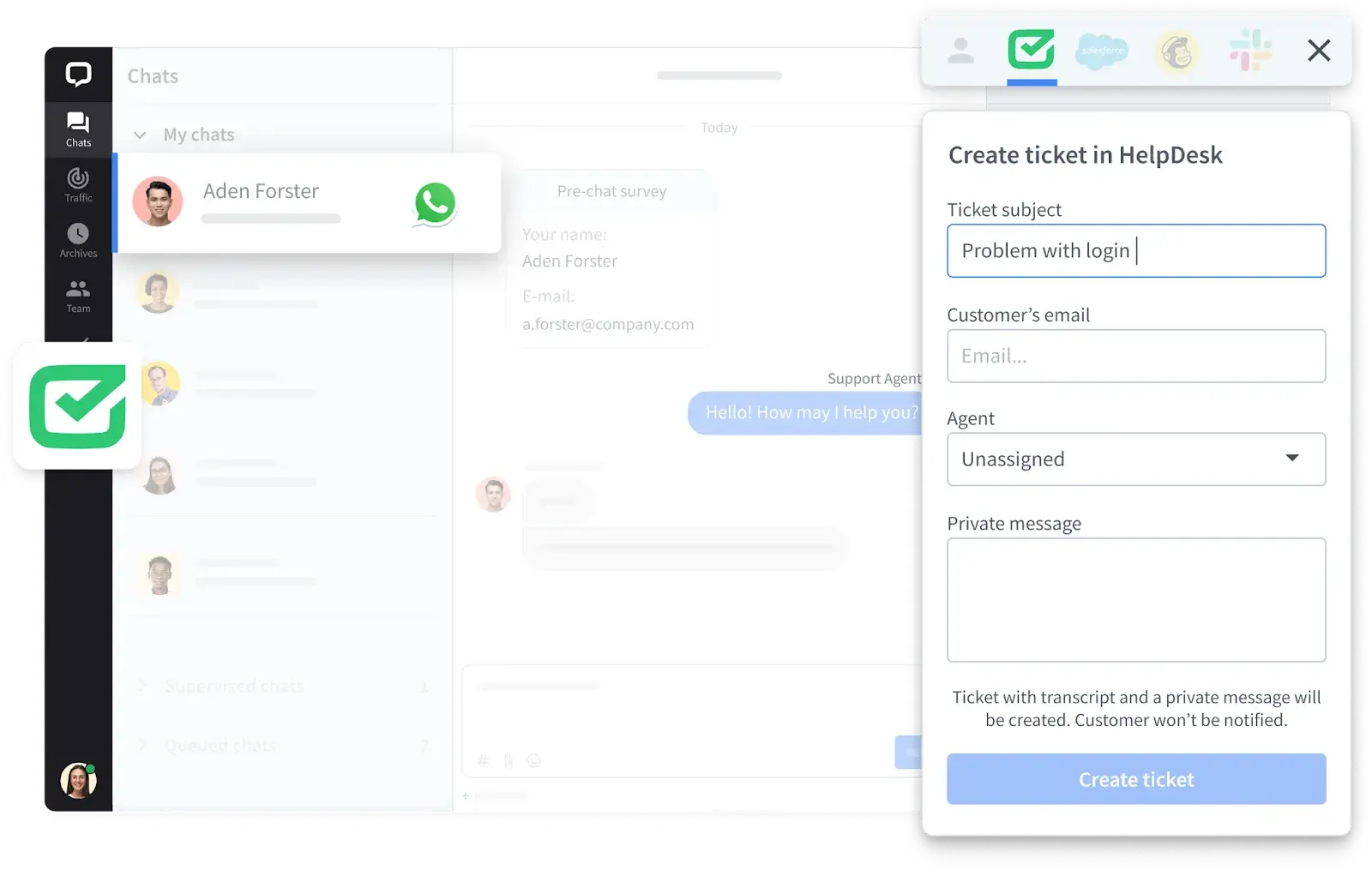
HelpDesk is an advanced ticketing system designed to enhance customer support operations for businesses of all sizes. With its intuitive interface and powerful features, HelpDesk enables support teams to efficiently manage customer inquiries across multiple channels, including email, chat, and social media.
Key Features
- Ticket management: Logs, tracks, and prioritizes customer cases. Each customer inquiry or problem is assigned a unique ticket.
- Issue resolution: Facilitates the resolution of customer issues by providing a platform for support agents to communicate with customers, troubleshoot issues, and offer solutions.
- Asynchronous communication: Communication between support agents and customers via various channels, including email, chat, contact form, and social media.
- Effortless automation: Automation and AI-based features help streamline repetitive tasks, route tickets to the appropriate departments, and provide quick responses to common queries, improving the efficiency of support operations.
- Feedback collection: Gathering customer feedback is essential for understanding their needs and improving products and services.
- Analytics and reporting: Create visual reports to better understand agent performance and customer satisfaction rates.
- Knowledge base: Create an optimized library of troubleshooting articles.
- Personalization: Brand your communications with a custom domain and address.
Pros
- User-friendly interface: Intuitive and easy-to-navigate interface, making it accessible even for non-technical users.
- Automation features: It offers robust automation capabilities such as automated workflows, ticket assignments, and canned responses.
- Customizable ticketing system: The platform allows users to customize their ticketing workflows to fit their support process. You can set rules for prioritizing tickets, create tags, and categorize tickets for better organization.
- Integration with other tools: Integrates well with other tools, such as Webflow, WordPress, LiveChat, and email providers.
- Analytics and reporting: The platform offers insightful reports on ticket resolution times, team performance, and customer satisfaction, providing teams with the data they need to improve support quality.
Cons
- Limited free tier: Offers a free version of HelpDesk for 14 days. Long-term free options are unavailable; however, you can choose between three plans designed to best suit your team.
- Asynchronous communication only: HelpDesk is ideal for handling tickets and asynchronous communication, but it doesn’t support synchronous chat features (only by integration, such as LiveChat).
Best for: Small and medium-sized businesses looking for a branded solution to connect all their customer communication in one simple dashboard.
What I like: I really like HelpDesk because it is simple to use for handling customer support tasks. The user-friendly interface makes it easy for anyone to manage tickets without a steep learning curve. The automation features include setting up workflows and automating repetitive tasks, streamlining support processes, saving time, and improving team productivity.
Another strength of HelpDesk is how it centralizes communication. This allows businesses to manage all their customer inquiries in one place, whether they come from emails or contact forms. In addition, its integration capabilities with tools like LiveChat allow businesses to build a more cohesive support ecosystem.
Pricing: You can sign up for a 14-day free trial. Paid subscriptions start at $29 a month per team member.
How to Choose the Right Support Ticketing Tool
Your support ticketing tool significantly impacts your team’s ability to do their jobs efficiently and solve for the customer. Accordingly, selecting your help desk warrants some serious consideration. But how do you know you’re choosing the right one?
I think it comes down to finding a tool that strikes the right balance between features and budget.
Assess your needs.
When choosing your support ticketing system, the first step is to evaluate your needs. There are many factors to consider.
- How large is your team?
- What’s your expected volume of incoming tickets?
- What channels will customers be contacting you from?
- Do you have any unique requirements or needs for special features like automation or AI?
Your answers to these questions will be the baseline criteria for selecting your help desk. For example, if you run a small support team that only handles limited email inquiries, you’ll only need a lightweight system. In comparison, a large enterprise team may require a robust solution with customization options and the ability to handle hundreds of team members.
Identify key features.
I touched on this above, but assessing your needs will help inform the key features your team requires. Some examples of make-or-break features may include:
- Ticket automation and follow-up.
- Reporting capabilities.
- Integration options.
- Omnichannel ticketing.
- SLA (service level agreement) management.
And much more. Based on your team's needs, I suggest making a list of required features and “nice to have” features. Then, search for help desk software that checks off as many boxes as possible within your budget, which brings me to the next step.
Set a budget.
It all comes down to money, of course. Setting a budget for your customer service ticket system will help narrow your options. You want to maximize value, meaning you get the most high-quality features for your money.
I think help desk software isn’t the place to cut corners. If ever there was a place to stretch that budget a little, it’s here. Why? Because it’s an essential tool for your team’s ability to satisfy customers. It’s not worth cheaping out on your help desk software if it means missing out on critical features and creating a bottleneck in your ability to help customers.
That being said, it all depends on your needs, and if your needs are basic, you can take advantage of many free help desk solutions.
Consider scalability.
I think it’s critical to choose a customer ticketing software that can grow with your team. Many solutions offer a free tier, which is excellent for smaller teams just starting out. However, it’s essential to consider your team’s growth trajectory when selecting the right option.
After all, you don’t want to choose help desk software that you’ll need to replace after only a year or two, which will result in lots of lost time in retraining and integrating a new system into your workflow.
Service desk software like HubSpot is fantastic because it offers a free option to get you started. There are then increasing paid tiers that expand upon feature sets to align with your growing business needs.
Test multiple tools.
I’ve been writing about and researching customer service software for a while now, and I’ve found that the market is relatively competitive. What I mean is, generally, there is parity regarding features and capabilities amongst the foremost service desk options.
So, how do you choose between solutions that offer the same features at similar price points? That’s where the fun comes in. Testing!
Well, maybe it’s only fun if you’re a software nerd like me. Regardless, it’s essential to audition a few tools to figure out which fits your workflow best.
How I Chose the Best Help Desk Software
After testing many free help desk ticketing systems, there can only be one winner. Well, actually, there are two. My favorite free helpdesk solutions are UVdesk and HubSpot.
I considered two factors when forming my opinion on my favorite help desk ticketing systems: first impression and value.
First impressions are everything, and when it comes to evaluating software, that equates to my initial experience with the UI and how intuitive it feels to navigate around the product and locate the features and functionality I’m looking for. UVdesk and HubSpot both pass this test. UVdesk’s interface is more basic than HubSpot, but what it lacks in looks, it makes up for in value.
Value is a big one. In my mind, value is the idea of how much you’re getting for what you pay. Of course, you want the most bang for your buck. Now, both of these options are free, so what you pay isn’t always money. UVdesk and HubSpot both offer a competitive feature set that keeps up with the competition.
UVDesk
When it comes to free software solutions, there’s usually some kind of trade-off. Typically, you get fewer features compared to paid versions, or you have to put up with banner ads in the header and sidebar. However, the only trade-off with UVdesk is effort. It’s not for everyone due to its open-source, self-hosted nature and technical implementation, but the amount of premium features and customization available within UVdesk blew me away.
If you have the technical experience or development resources to deploy and maintain UVdesk, you have an enterprise-level ticketing system for free. The time and effort required to deploy and maintain such a system are a cost to consider, but if UVdesk is the right fit for your team, then I think the value is astronomical.
HubSpot
I’ll admit it: I have a SoftSpot for HubSpot (see what I did there). All jokes aside, HubSpot strikes the perfect balance between value and usability. The HubSpot interface is remarkably intuitive and attractive, and I would be happy to look at it daily.
Regarding features, the free version of HubSpot Help Desk won’t give you access to all the enterprise-level features you’re getting with UVdesk for free. However, I believe that 99% of small organizations are better suited for a solution like HubSpot. At the free tier, HubSpot offers all the help desk features you’ll need to run a basic customer service operation, and it is effortless to get up and running.
What sets HubSpot apart from similar help desk ticketing systems is its potential for scalability. HubSpot can grow with your business and become the complete operational hub for your entire organization. Native integration with HubSpot’s free CRM alone is a remarkable value that brings elevated visibility into customer interactions compared to other options on this list.
Find the Right Help Desk Software for Your Team
As your company grows and takes on new clients, your customer service team will also work to keep up with increased demand for customer support requests. Help desk software will allow reps to effectively and efficiently organize those requests, manage ticket volume, and provide support.
After testing all these different help desk solutions, I’ve found that my favorite ones are those with the sleekest, most minimal UI. For the most part, all of the help desk solutions on the market offer similar capabilities and features, so your choice should come down to usability and workflow within your budget.
Editor's note: This post was originally published in March 2019 and has been updated for comprehensiveness.
.webp?)
Free Help Desk & Ticketing Software
Keep track of customer requests in one unified help desk that connects to your CRM database.
- Provide personalized, AI-powered support to your customers
- Save time, reduce errors, and streamline service processes
- Improve rep efficiency & time to resolution
- And more!
.webp?width=112&height=112&name=Help-Desk-EN@3x%20(1).webp)

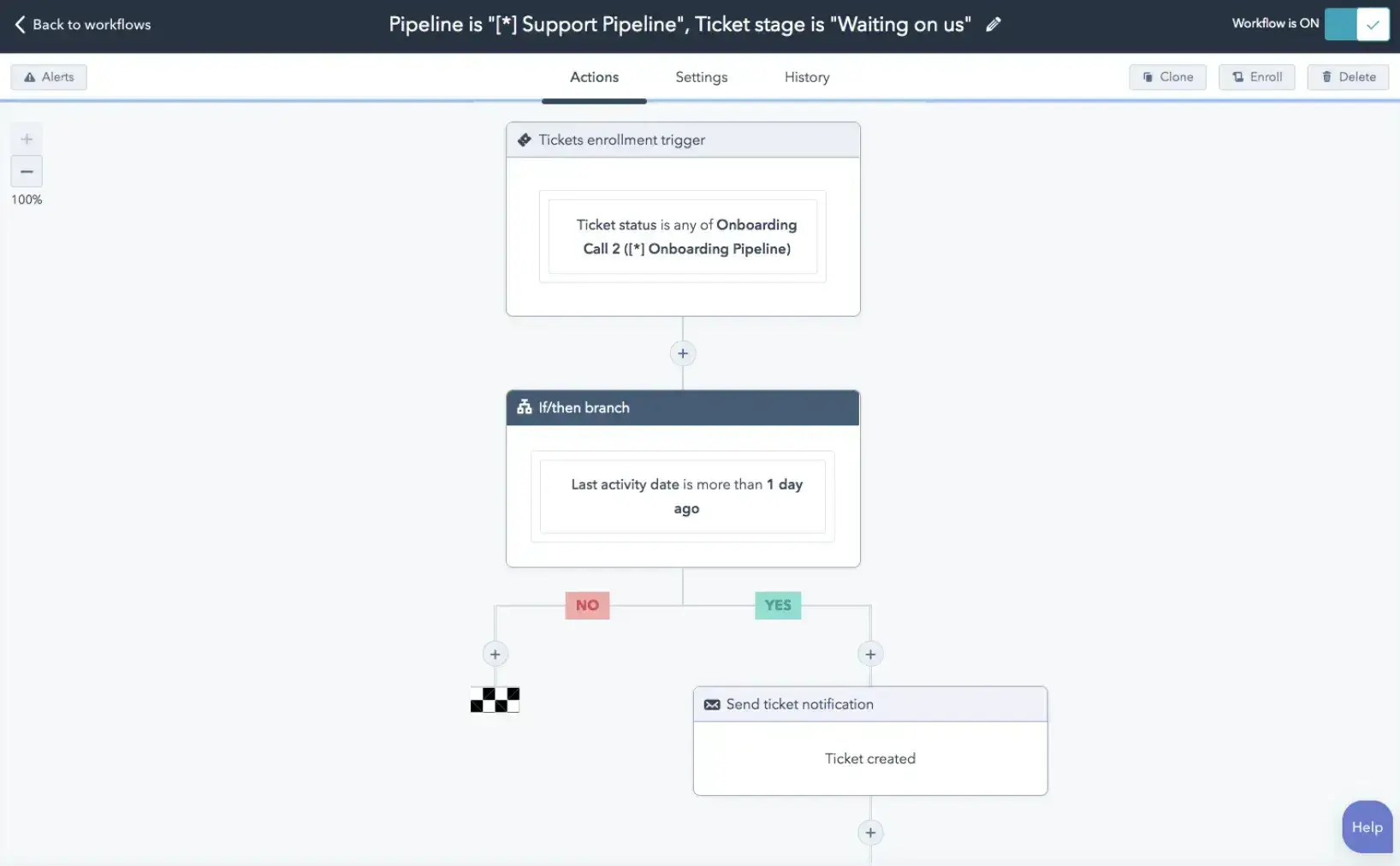




![Why Gen Z Demands Exceptional Customer Support [New Data]](https://www.hubspot.com/hubfs/Featured%20Image%20Template%20Backgrounds_AC%20Copy.png)




